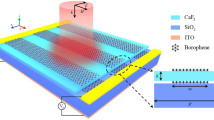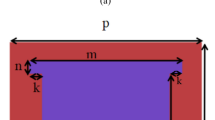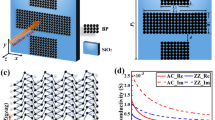Abstract
In this paper, we designed a multi-layer borophene-based nanoribbons metasurface and achieved a dynamically tunable plasmon-induced transparency (PIT) effect. The numerical results indicate that the parallel multi-layer borophene nanoribbons (BNRs) support the PIT effect. This can be seen as a PIT effect caused by bright-bright mode excitation and coupling between upper and lower layer. The physical principles of the double-layer nanoribbons model can be theoretically demonstrated by using the two-particle model. Due to the heavier effective mass of borophene nanoribbons in the y-direction, when the placement direction of borophene nanoribbons is changed from the x-direction to the y-direction, the position of the PIT peak undergoes a significant red shift. By increasing the borophene carrier density in the model, the PIT window produces a blue shift. The PIT window can be tuned by changing the carrier concentration. Finally, the sensitivity and figure of merit (FOM) of the sensor are calculated, and the results are 55.3 THz/RIU and 86.58, respectively. The proposed structure has potential applications in the research and design of high-sensitivity sensors, optical switches, and optical storage.









Similar content being viewed by others
Data Availability
The data that support the findings of this study are available upon reasonable request from the authors.
References
Zhang J, Zhang L, Xu W (2012) Surface plasmon polaritons: physics and applications. J Phys D Appl Phys 45(11):113001
Ditlbacher H, Krenn JR, Schider G, Leitner A, Aussenegg FR (2002) Two-dimensional optics with surface plasmon polaritons. Appl Phys Lett 81(10):1762–1764
Ritchie RH (1957) Plasma losses by fast electrons in thin films. Phys Rev 106(5):874
Barnes WL, Dereux A, Ebbesen TW (2003) Surface plasmon subwavelength optics nature 424(6950):824–830
Zia R, Brongersma ML (2007) Surface plasmon polariton analogue to Young’s double-slit experiment. Nat Nanotechnol 2(7):426–429
Sandtke M, Kuipers L (2007) Slow guided surface plasmons at telecom frequencies. Nat Photonics 1(10):573–576
Zhang Y, Min C, Dou X, Wang X, Urbach HP, Somekh MG, Yuan X (2021) Plasmonic tweezers: for nanoscale optical trapping and beyond. Light Sci Appl 10(1):59
Law S, Podolskiy V, Wasserman D (2013) Towards nano-scale photonics with micro-scale photons: the opportunities and challenges of mid-infrared plasmonics. Nanophotonics 2(2):103–130
Wang W, Li Y, Chen F, Cheng S, Yang W, Wang B, Yi Z (2023) A TM polarization absorber based on a graphene–silver asymmetrical grating structure for near-infrared frequencies. Phys Chem Chem Phys
Meng Q, Chen F, Xu Y, Cheng S, Yang W, Yao D, Yi Z (2023) Multi-frequency polarization and electro-optical modulator based on triple plasmon-induced transparency in monolayer graphene metamaterials. Diam Relat Mater 138:110216
Maier SA (2006) Plasmonics: metal nanostructures for subwavelength photonic devices. IEEE J Sel Top Quantum Electron 12(6):1214–1220
Zhao H, Guang X, Huang J (2008) Novel optical directional coupler based on surface plasmon polaritons. Physica E 40(10):3025–3029
Chen J, Nie H, Peng C, Qi S, Tang C, Zhang Y, Wang L, Park GS (2018) Enhancing the magnetic plasmon resonance of three-dimensional optical metamaterials via strong coupling for high-sensitivity sensing. J Lightwave Technol 36(16):3481–3485
Rakhshani MR, Mansouri-Birjandi MA (2018) A high-sensitivity sensor based on three-dimensional metal–insulator–metal racetrack resonator and application for hemoglobin detection. Photonics Nanostructures-Fundam Appl 32:28–34
Deng Y, Cao G, Yang H (2018) Tunable Fano resonance and high-sensitivity sensor with high figure of merit in plasmonic coupled cavities. Photonics Nanostructures-Fundam Appl 28:45–51
Lu X, Shi J, Liu R, Guan C (2012) Highly-dispersive electromagnetic induced transparency in planar symmetric metamaterials. Opt Express 20(16):17581–17590
Zhang J, Dong R, Chang H, Xie C, Peng K, Xiao M (2001) Experimental demonstration of electromagnetic induced transparency and dispersion effects in Cs atom vapour. Chin Phys Lett 18(12):1586
He X, Yang X, Li S, Shi S, Wu F, Jiang J (2016) Electrically active manipulation of electromagnetic induced transparency in hybrid terahertz metamaterial. Opt Mater Express 6(10):3075–3085
Zhao H, Ren Y, Fang L, Lin H (2020) Electromagnetic induced transparency in graphene waveguide structure for Terahertz application. Results in Physics 16:102971
Chen L, Xu J, Gao C, Zang X, Cai B,1 Zhu Y (2013) Manipulating terahertz electromagnetic induced transparency through parallel plate waveguide cavities. Appl Phys Lett 103(25)
Zafar R, Salim M (2015) Achievement of large normalized delay bandwidth product by exciting electromagnetic-induced transparency in plasmonic waveguide. IEEE J Quantum Electron 51(10):1–6
Zheng S, Ma M, Lv Y, Fu T, Peng L, Zhao Q (2022) Dual-band electromagnetically induced transparent metamaterial with slow light effect and energy storage. J Phys D Appl Phys 55(25):255103
Han L, Tan Q, Gan Y, Zhang W, Xiong J (2020) Polarization-insensitive classical electromagnetically induced transparency metamaterial with large group delay by Dirac semimetal. Results Phys 19:103377
Li P (2023) Dual plasmon-Induced transparency in two-dimensional metamaterials with coupled resonators. Mater Express 13(2):395–400
Cao G, Li H, Deng Y, Zhan S, He Z, Li B (2014) Plasmon-induced transparency in a single multimode stub resonator. Opt Express 22(21):25215–25223
Luk’Yanchuk B, Zheludev N I, Maier S A, Halas N J, Nordlander P, Giessen H, Chong C T, (2010) The Fano resonance in plasmonic nanostructures and metamaterials. Nat Mater 9(9):707–715
Zhao X, Yuan C, Zhu L, Yao J (2016) Graphene-based tunable terahertz plasmon-induced transparency metamaterial. Nanoscale 8(33):15273–15280
Zhu Z, Yang X, Gu J, Jiang J, Yue W, Tian Z, Tonouchi M, Han J, Zhang W (2013) Broadband plasmon induced transparency in terahertz metamaterials. Nanotechnology 24(21):214003
Chen H, Zhang H, Zhao Y, Liu S, Cao M, Zhang Y (2018) Broadband tunable terahertz plasmon-induced transparency in Dirac semimetals. Opt Laser Technol 104:210–215
Li D, Ji Z, Luo C (2020) Optically tunable plasmon-induced transparency in terahertz metamaterial system. Opt Mater 104:109920
Kekatpure RD, Barnard ES, Cai W, Brongersma ML (2010) Phase-coupled plasmon-induced transparency. Phys Rev Lett 104(24):243902
Nurmohammadi T, Abbasian K, Mashayekhi MZ (2022) Graphene-based tunable plasmon-induced transparency utilizing circular and two rectangular gold rings in the near-infrared spectrum. Mater Sci Semicond Process 144:106601
Yang S, Zhou R, Liu D, Lin Q, Li S (2019) Controlling the plasmon-induced transparency system based on Dirac semimetal at mid-infrared band. Opt Commun 449:13–18
Biswas S, Duan J, Nepal D, Park K, Pachter R, Vaia RA (2013) Plasmon-induced transparency in the visible region via self-assembled gold nanorod heterodimers. Nano Lett 13(12):6287–6291
Jia Z, Huang L, Su J, Tang B (2020) Tunable plasmon-induced transparency based on monolayer black phosphorus by bright-dark mode coupling. Appl Phys Express 13(7):072006
Cao M, Wang H, Li L (2018) Dynamically adjusting plasmon-induced transparency and slow light based on graphene meta-surface by bright–dark mode coupling. Phys Lett A 382(30):1978–1981
Wan M, Sun X, Song Y, Ji P, Zhang X, Ding P, He J (2017) Broadband plasmon-induced transparency in plasmonic metasurfaces based on bright-dark-bright mode coupling. Plasmonics 12:1555–1560
Shu C, Chen Q, Mei J, Yin J (2018) Dynamically tunable implementation of electromagnetically induced transparency based on bright and dark modes coupling graphene-nanostrips. Opt Commun 420:65–71
Fu G, Zhai X, Li H, Xia S, Wang L (2016) Tunable plasmon-induced transparency based on bright-bright mode coupling between two parallel graphene nanostrips. Plasmonics 11:1597–1602
Chen H, Zhang H, Liu M, Zhao Y, Guo X, Zhang Y (2017) Realization of tunable plasmon-induced transparency by bright-bright mode coupling in Dirac semimetals. Opt Mater Express 7(9):3397–3407
Zhang H, Cao Y, Liu Y, Li Y, Zhang Y (2017) A novel graphene metamaterial design for tunable terahertz plasmon induced transparency by two bright mode coupling. Opt Commun 391:9–15
Hu X, Yuan S, Armghan A, Liu Y, Jiao Z, Lv H, Xia J (2016) Plasmon induced transparency and absorption in bright–bright mode coupling metamaterials: a radiating two-oscillator model analysis. J Phys D Appl Phys 50(2):025301
Hou C, Tai G, Liu B, Wu Z, Yin Y (2021) Borophene-graphene heterostructure: preparation and ultrasensitive humidity sensing. Nano Res 1–8
Zhang H, Wu A, Xiao K, Huang X, Jiang H, Zhao W (2023) Dual-controllable plasmon-induced transparency based on active borophene metasurface in the near-infrared region. Plasmonics 18(2):761–768
Jiang J, Xu Y, Li Y, Ren L, Chen F, Cheng S, Zhou X (2022) Triple-band perfect absorber based on the gold-Al2O3-grating structure in visible and near-infrared wavelength range. Opt Quant Electron 54(1):43
Dereshgi SA, Liu Z, Aydin K (2020) Anisotropic localized surface plasmons in borophene. Opt Express 28(11):16725–16739
He X, Yang X, Lu G, Yang W, Wu F, Yu Z, Jiang J (2017) Implementation of selective controlling electromagnetically induced transparency in terahertz graphene metamaterial. Carbon 123:668–675
Hu B, Huang M, Hong S, Yang J (2022) Dynamically tunable plasmon-induced transparency in parallel black phosphorus nanoribbons. Plasmonics 17(3):1235–1245
Cui W, Li C, Ma H, Xu H, Yi Z, Ren X, Liu Z (2021) Excellent sensing based on dual-plasmon induced transparency in graphene metasurface. Physica E 134:114850
Chen T, Wang J, Liang D (2023) A polarization-insensitive dual plasmon-induced transparency terahertz sensor based on graphene metamaterial. Opt Commun 129622
Chen T, Liang D, Jiang W (2022) A tunable terahertz graphene metamaterial sensor based on dual polarized plasmon-induced transparency. IEEE Sens J 22(14):14084–14090
Zhu A, Bu P, Cheng L, Hu C, Mahapatra R (2023) High-sensitivity sensor based on diametrical graphene strip plasma-induced transparency. In Photonics 10(7)830 MDPI
Xiao K, Li J, Zhang H, Jiang H, Zhao W (2023) Dynamically adjusting borophene-based plasmon-induced transparency in a polymer-separated hybrid system for broadband-tunable sensing. Polymers 15(14):3060
Alharbi AG, Sorathiya V, Lavadiya S (2022) A multi-layered borophene-silica-silver based refractive index sensor for biosensing applications operated at the infrared frequency spectrum. In Photonics 9(5):279 MDPI
Zhang J, Zhang Z, Song X, Zhang H, Yang J (2021) Infrared plasmonic sensing with anisotropic two-dimensional material borophene. Nanomaterials 11(5):1165
Shen J, Yang Z, Wang Y, Xu LC, Liu R, Liu X (2020) The gas sensing performance of borophene/MoS2 heterostructure. Appl Surf Sci 504:144412
Hou C, Tai GA, Liu B, Wu Z, Yin Y (2021) Borophene-graphene heterostructure: preparation and ultrasensitive humidity sensing. Nano Res 1–8
Hou C, Tai G, Liu Y, Liu R, Liang X, Wu Z, Wu Z (2022) Borophene pressure sensing for electronic skin and human-machine interface. Nano Energy 97:107189
Hou C, Tai G, Liu Y, Liu X (2022) Borophene gas sensor. Nano Res 1–8
Hou C, Tai G, Liu Y, Wu Z, Wu Z, Liang X (2021) Ultrasensitive humidity sensing and the multifunctional applications of borophene–MoS 2 heterostructures. J Mater Chem A 9(22):13100–13108
Funding
Supported by the National Natural Science Foundation of China (Grant Nos. 11747091, 11647122), The Natural Science Foundation of Hubei Province, China (Grant No. 2022CFB475), and Yangtze University College Students’ Innovation and Entrepreneurship (Grant No. Yz2022278).
Author information
Authors and Affiliations
Contributions
Yizhao Pan: investigation, methodology, software, formal analysis, writing—original draft, writing—review and editing. Fang Chen: investigation, methodology, software, formal analysis, writing—original draft, writing—review and editing, funding acquisition. Jianchang Yang: literature organization and writing. Yuchang Li: conceptualization, supervision, investigation, methodology, validation, formal analysis. Wenxing Yang: supervision, writing—review and editing. Boyun Wang: formal analysis, writing—review and editing
Corresponding author
Ethics declarations
Ethical Approval
Not applicable.
Conflict of Interest
The authors declare no competing interests.
Additional information
Publisher's Note
Springer Nature remains neutral with regard to jurisdictional claims in published maps and institutional affiliations.
Rights and permissions
Springer Nature or its licensor (e.g. a society or other partner) holds exclusive rights to this article under a publishing agreement with the author(s) or other rightsholder(s); author self-archiving of the accepted manuscript version of this article is solely governed by the terms of such publishing agreement and applicable law.
About this article
Cite this article
Pan, Y., Chen, F., Yang, J. et al. High-Sensitivity Sensor Based on Plasmon-Induced Transparency in Terahertz Borophene Metasurface. Plasmonics 19, 901–911 (2024). https://doi.org/10.1007/s11468-023-02046-x
Received:
Accepted:
Published:
Issue Date:
DOI: https://doi.org/10.1007/s11468-023-02046-x




